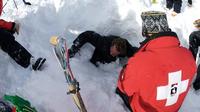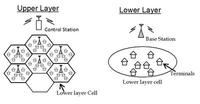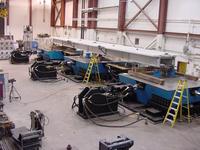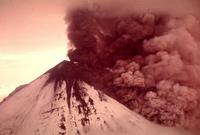-
Examining fire safety concerns raised by green buildings
In 2012, the “Fire Safety Challenges of Green Buildings” report assembled a list of seventy-eight green building features and construction elements that could have implications for fire safety. The authors then derived a list of potential hazards associated with the features and elements, including greater flammability, faster burn rate, and increased hindrance to firefighters, as compared with conventional construction. A 3-year project, funded with a $1 million grant from DHS, will enable the further exploration of some of the potential risks and hazards identified in the 2012 report.
-
-
Predicting sliding mountain slopes
If entire mountain slopes start to slide, danger threatens. It is not always easy to predict and monitor these mass movements. In an international project, scientists combined numerical models with microwave radar systems in Northern Tyrol — with promising results. The Steinlehnen slope in Northern Tyrol (Austria) started to move in 2003. Rockfalls threatened people, streets, and buildings. Meanwhile, peace has returned; although the slope is merely “creeping,” Steinlehnen has become an interesting research object for scientists in recent years.
-
-
Allowing Terrorism Risk Insurance Act to expire could hurt national security: Study
The current terrorism risk insurance program has a $27.5 billion threshold for aggregate losses that are paid by the insurance industry and commercial policyholders before the government program begins paying. The program will expire in 2014 and Congress again is considering the appropriate government role in terrorism insurance markets. Allowing the federal terrorism risk insurance act to expire could have negative consequences for U.S. national security, according to a new study from the RAND Corporation.
-
-
2011 Oklahoma human-induced earthquake may have triggered larger quake
In a new study, scientists observed that a human-induced magnitude 5.0 earthquake near Prague, Oklahoma in November 2011 may have triggered the larger M5.7 earthquake less than a day later. This research suggests that the M5.7 quake was the largest human-caused earthquake associated with wastewater injection.
-
-
Accelerated urbanization exposes French cities to increased seismic risk
Old structures, designed before current seismic building codes, abound in France, and there is insufficient information about how they will respond during an earthquake. French researchers have looked into data mining to develop a method for extracting information on the vulnerability of cities in regions of moderate risk, creating a proxy for assessing the probable resilience of buildings and infrastructure despite incomplete seismic inventories of buildings. The research exposes significant vulnerability in regions that have experienced an “explosion of urbanization.”
-
-
App helps save people trapped by avalanche

For the person buried under the weight of an avalanche, each minute is precious. A person saved from the snow mass within fifteen minutes has a 90 percent chance of survival. After forty-five minutes that chance has diminished considerably. Researchers develop an app that makes it possible for skiers with smartphones to find people buried in the snow.
-
-
Safeguarding networks when disasters strike

Disasters both natural and human-caused can damage or destroy data and communications networks. Several presentations at the 2014 OFC Conference and Exposition, being held 9-13 March in San Francisco, will present new information on strategies that can mitigate the impacts of these disasters. Researchers created an algorithm that keeps data safe by moving or copying the data from data centers in peril to more secure locations away from the disaster. The algorithm assesses the risks for damage and users’ demands on the network to determine, in real-time, which locations would provide the safest refuge from a disaster. Other researchers suggest that if fiber-optic cables are down, wireless communication can fill the void and be part of a temporary, emergency network. For such a system to work, however, wireless technology would have to be integrated with the fiber-optic network that transports data around the world.
-
-
Large shake tables expands capabilities of U Nevada, Reno’s quake engineering lab

When it opens, the University of Nevada, Reno’s new Earthquake Engineering Laboratoryt will join with the internationally renowned Large-Scale Structures Laboratory to comprise the largest and most versatile structural engineering experimental facility in the United States. Researchers at the facility will conduct research aiming to test new designs and materials that will make buildings, bridges, and highways safer.
-
-
Flood risk in Europe could double by 2050
Losses from extreme floods in Europe could more than double by 2050 because of climate change and socioeconomic development. Floods in the European Union averaged 4.9 billion euros a year from 2000 to 2012. These average losses could increase to 23.5 billion euros by 2050. In addition, large events such as the 2013 European floods are likely to increase in frequency from an average of once every sixteen years to a probability of once every ten years by 2050. Understanding the risk posed by large-scale floods is of growing importance and will be a key for managing climate adaptation.
-
-
What use are apps when your web infrastructure is underwater?
This winter has seen unprecedented high winds and flooding resulting in widespread and in some cases, long-lasting power outages in the United Kingdom, particularly in the west of England. Time and time again, companies have advised their customers to go online to check their Web sites for the latest information. Some organizations have even created apps specifically designed to assist flood victims; others have established Facebook self-help groups. There is a fundamental problem here: There are two primary ways in which we gain access to the Web, via a landline and using a mobile connection. Within our homes the landline connects to a wireless router and also, for a lot of homes, a cordless telephone, both of which need electrical power to work. So, when the lights go out, your router and cordless phones are useless. The result is that at times of crisis, the customers in most need are often the ones with no access.
-
-
Real-time forecast of Hurricane Sandy accurately predicted storm’s track, intensity
A real-time hurricane analysis and prediction system that effectively incorporates airborne Doppler radar information may accurately track the path, intensity, and wind force in a hurricane. This system also can identify the sources of forecast uncertainty.
-
-
Volcanoes can go from dormant to active quickly
A new study suggests that the magma sitting 4-5 kilometers beneath the surface of Oregon’s Mount Hood has been stored in near-solid conditions for thousands of years, but that the time it takes to liquefy and potentially erupt is surprisingly short — perhaps as little as a couple of months. The key, scientists say, is to elevate the temperature of the rock to more than 750 degrees Celsius, which can happen when hot magma from deep within the Earth’s crust rises to the surface.
-
-
Volcanic eruptions explain recent warming hiatus

Volcanic eruptions in the early part of the twenty-first century have cooled the planet, according to a study led by Lawrence Livermore National Laboratory. This cooling has partly offset the warming produced by greenhouse gases, explaining why, despite continuing increases in atmospheric levels of greenhouse gases, and in the total heat content of the ocean, global-mean temperatures at the surface of the planet and in the troposphere (the lowest portion of the Earth’s atmosphere) have shown relatively little warming since 1998. Scientists note that human-induced – that is, greenhouse gasses emissions-related — change typically causes the troposphere to warm and the stratosphere to cool. In contrast, large volcanic eruptions cool the troposphere and warm the stratosphere.
-
-
Unsupervised robotic construction crew to build flood defenses
On the plains of Namibia, millions of tiny termites are building a mound of soil — an 8-foot-tall “lung” for their underground nest. They do so without a supervisor, foreman, or CEO to tell them what to do. During a year of construction, many termites will live and die, wind and rain will erode the structure, and yet the colony’s life-sustaining project will continue. Harvard researchers, inspired by the termites’ resilience and collective intelligence, have created an autonomous robotic construction crew. The system needs no supervisor, no eye in the sky, and no communication: just simple robots — any number of robots — that cooperate by modifying their environment. In the future, similar robots could lay sandbags in advance of a flood, or perform simple construction tasks on Mars.
-
-
Large offshore wind farms could weaken hurricanes before they make landfall
Computer simulations have shown that offshore wind farms with thousands of wind turbines could have sapped the power of three real-life hurricanes, significantly decreasing their winds and accompanying storm surge, and possibly preventing billions of dollars in damages. For example, an array of 78,000 wind turbines off the coast of New Orleans would have significantly weakened Hurricane Katrina well before it made landfall, reducing wind speeds between 80 and 98 mph, and decreasing the storm surge by up to 79 percent.
-
More headlines
The long view
Using Drone Swarms to Fight Forest Fires
Forest fires are becoming increasingly catastrophic across the world, accelerated by climate change. Researchers are using multiple swarms of drones to tackle natural disasters like forest fires.
How Climate Change Will Affect Conflict and U.S. Military Operations
“People talk about climate change as a threat multiplier,” said Karen Sudkamp, an associate director of the Infrastructure, Immigration, and Security Operations Program within the RAND Homeland Security Research Division. “But at what point do we need to start talking about the threat multiplier actually becoming a significant threat all its own?”
